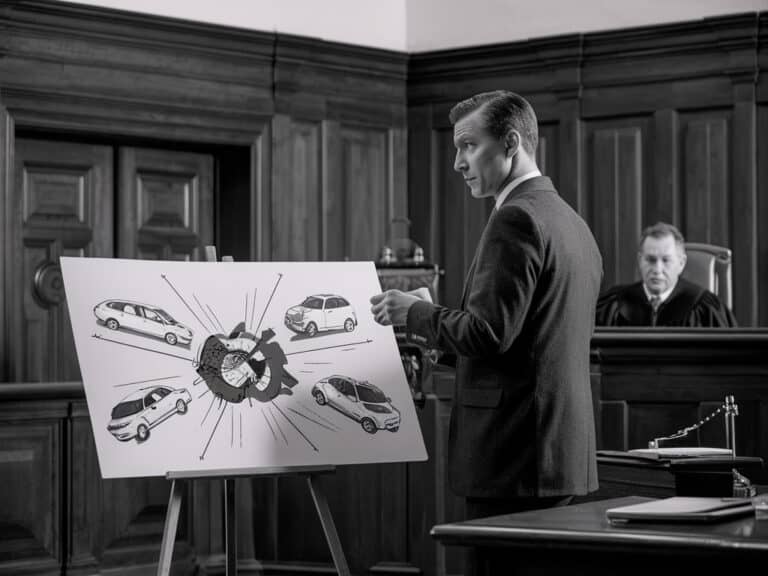Ever been in a car insurance pickle? Picture this: you’re cruising down Interstate 95, wind blowing through your hair. Suddenly – bang! You’ve hit something.
Your heart skips a beat. Panic sets in as thoughts of paperwork and repair costs race through your mind.
You see, car insurance isn’t just another tedious box to tick off the adulting checklist. It’s more like an invisible safety net ready to catch us when we fall…or rather, crash.
In this ride together, we’ll unravel the mysteries of property coverage, decipher deductibles’ cryptic language and navigate state requirements maze-like twists and turns.
A detour or two might take us down memory lane as we share personal stories from those bumpy roads that caught us unprepared.
Let’s begin our journey!
Table Of Contents:
- Understanding Car Insurance Coverage
- The Importance of Deductibles in Car Insurance Policies
- State Requirements for Car Insurance
- How to Get a Car Insurance Quote
- The Aftermath of a Car Accident: What to Do
- FAQs in Relation to Car Insurance
- Conclusion
Understanding Car Insurance Coverage
The enigma of car insurance protection can be confounding, yet when you comprehend the rudiments it’s really quite straightforward. There are three main types: property, liability, and medical.
The Role of Property Insurance in Car Insurance
First up is property insurance. This type covers damage to or theft of your car. If a rogue baseball smashes your windshield or someone decides they fancy your vehicle for their own use – this is where property insurance steps in.
This coverage not only helps fix damages inflicted on your vehicle but also extends its protective wings over personal properties inside the car at the time of an unfortunate event like burglary or vandalism.
Liability Insurance Explained
Moving onto liability insurance – it’s all about responsibility here folks. Say you’re behind the wheel and cause an accident (yes, we’ve all had those moments). You’ll be liable for any resulting bodily injury or property damage due to the laws of automobile regulations. “Why?”, you ask? Well because that’s how automobile laws work my friend.
Your liability cover makes sure that if other parties decide to file lawsuits against you (and believe me people do), it takes care of legal expenses too. So no more lying awake worrying about those lawyer fees eating into your pizza budget.
PIP Coverage in Auto Insurance
Personal Injury Protection (PIP) coverage – this is great no-fault coverage that can be applied to both medical bills and lost wages.
Medical Coverage in Car Insurance
Last up is medical coverage – trust me when I say this one comes handy during times when Lady Luck isn’t smiling down at us quite so brightly as usual. It pays for treating injuries; rehabilitating lost physical abilities after serious accidents; sometimes even lost wages and funeral costs.
Imagine you’re on your way to pick up that new book from the library, a vehicle hits yours out of nowhere. The impact leaves you with injuries requiring medical attention. This is where this coverage comes in – like a knight in shining armor.
Note: Insurance coverages can vary based on several factors such as your driver’s license status, credit cards’ insurance policies or even the general consensus among different insurance companies about risk levels associated with specific types of vehicles.
A Final Thought
Let’s get to the point.
The Importance of Deductibles in Car Insurance Policies
Imagine your car insurance policy as a safety net. But before this net starts to catch you, there’s a small gap you need to cover on your own. That gap is what we call the deductible.
A deductible, put simply, is the amount of money that you must pay out-of-pocket towards an insured loss before your auto insurance coverage steps in and picks up the rest. The deductible has a direct impact on how much your car insurance costs each month because it influences how risk is shared between you and your insurer.
Deductibles Explained: How They Work
When choosing an auto insurance policy, one crucial decision involves setting the right deductible level for yourself. This can feel like walking a tightrope—set it too high and sudden expenses might knock you off balance; set it too low and over time, increased premiums could weigh heavy on your wallet.
Your premium—the monthly or annual payment made to keep an active policy—is inversely related to deductibles; higher deductibles generally lead to lower premiums while lower deductibles tend to raise them. For example, if John sets his collision coverage with $1k deductible instead of $500, he may see significant savings on his premium payments but will have more out-of-pocket expense should he ever be involved in an accident. Insurance.com explains further about this relationship here.
Navigating Your Policy’s Fine Print: When Deductibles Apply
In general terms, a deductible applies to coverage types like collision and comprehensive, which cover damages to your vehicle. It’s critical to be aware of the details of your policy, since each one can differ.
But let’s say someone else hits your parked car while backing up. In this case, their insurance should take care of the damages, not yours. That’s how it typically works.
Key Takeaway:
Think of your car insurance deductible as the gap you must bridge before your safety net—your policy—kicks in. Choosing a higher deductible can lead to lower monthly premiums, but more out-of-pocket costs if an accident occurs. Remember, deductibles typically apply to collision and comprehensive coverages.
State Requirements for Car Insurance
If you’re a driver, it’s crucial to know that nearly all states in the US require car insurance. However, each state has its own set of auto insurance requirements that motorists must adhere to.
Understanding Uninsured Motorist Coverage
In some states, having uninsured motorist coverage is mandatory. This type of policy provides protection if an accident occurs with a driver who doesn’t have their own auto insurance or lacks sufficient coverage. It can help cover medical expenses and property damage costs. Check your specific state’s regulations to make sure you are compliant.
The consequences of driving without valid car insurance vary by state but generally involve hefty fines, license suspension or even jail time. So, it’s essential to understand what your particular location requires from drivers regarding auto insurance coverage.
Variations in State-by-State Auto Insurance Laws
Laws on required minimums for different types of vehicle coverage also vary across the country. For instance, California law requires $15k per person/$30k per accident bodily injury liability plus $5k property damage liability as minimum limits; whereas South Carolina law, on the other hand mandates $25k personal injury protection (PIP), under-insured motorist at 25/50/20 levels plus collision/comprehensive subject to deductibles – this shows just how diverse rules can be.
Maryland Auto Insurance
Maryland has specific auto insurance requirements that drivers must meet. As of my last knowledge update in January 2022, the minimum auto insurance requirements in Maryland include:
- Liability Insurance:
- Bodily Injury Liability: $30,000 per person and $60,000 per accident.
- Property Damage Liability: $15,000 per accident.
- Uninsured Motorist Coverage:
- Bodily Injury: $30,000 per person and $60,000 per accident.
- Property Damage: $15,000 per accident.
- Personal Injury Protection (PIP):
- At least $2,500 in PIP coverage.
Please note that these requirements may have changed since my last update. It’s important to verify the current auto insurance requirements with the Maryland Motor Vehicle Administration (MVA) or your insurance provider, as insurance requirements can change over time. Additionally, drivers may choose to purchase higher coverage limits or additional coverage types for better protection.
Navigating Financial Responsibility Laws
A few states don’t necessarily require car insurance as such but instead insist on proof of financial ability to cover damages in case of an accident. Proof of financial ability to pay for any damages or injuries resulting from an accident caused by the driver’s negligence must be provided.
cover all your expenses if you’re involved in a serious accident. Therefore, it’s wise to think about getting more coverage than what is simply required by your state. This is to guarantee that you are adequately safeguarded and set up for any conceivable street circumstance.
Key Takeaway:
Understanding your state’s car insurance requirements is crucial. Nearly every US state requires some form of auto insurance, yet the specifics can differ significantly – from obligatory uninsured motorist coverage to various minimums for different types of vehicle coverage. Some states even replace standard car insurance with proof-of-financial-responsibility laws. It’s important to check your local regulations and consider going beyond just meeting the bare minimum to ensure you’re fully protected on the road.
How to Get a Car Insurance Quote
The first step towards getting your car insured is understanding how to get a car insurance quote. Obtaining a car insurance quotation can be achieved promptly and competently, regardless of whether you opt to do it on the web or by phone. Let’s break down each method. Visit different sites to have better insurance options.
Getting an Online Car Insurance Quote
To get car insurance quotes, visit the website of an auto or any vehicle insurance company that catches your eye. Look for their “Get a Quote” button—usually found on their homepage—and click on it.
You’ll then need to provide some basic information about yourself and your vehicle. This often includes details like your name, address, date of birth, driver’s license number as well as facts about the car you want to insure such as its make, model and year.
Your driving history will also play into determining your potential rate so expect questions around past accidents or traffic violations if any exist in your record.
Finding Auto Insurance Quotes Over The Phone
If digital isn’t quite up-to-speed with you yet or you simply prefer human interaction when discussing financial matters—you’re not alone. Many people choose traditional methods like calling up an insurer directly for their quotes instead. Some insurance companies have established mobile app too!
This way offers personalized service where all doubts are clarified instantly by talking one-on-one with an agent who can answer questions related specifically to what’s most important: You.
Saving Time With Free Auto Quotes
- No waiting in lines,
- No scheduling appointments,
- No time spent traveling back-and-forth between offices—all from the comfort of home.
It’s essential to be honest and accurate when providing information for your car insurance quote, as the insurer may verify it; any inconsistencies could lead to policy denial or cancellation. Insurance companies have ways of verifying details given by customers; discrepancies could lead to a denial in coverage or cancellation of the policy if discovered after issuing.
So, don’t hold back. Jump right in and get that auto insurance quote. Remember, it’s not as scary as it seems with these steps and considerations at your fingertips.
Key Takeaway:
When you’re shopping for car insurance, getting a quote is your first move. You can snag one online by popping over to the insurer’s website and hitting their ‘Get a Quote’ button. If you prefer a personal touch, give them a call instead. Be ready to dish out some details about yourself, your ride, and how you’ve handled it on the road so far. And remember – honesty is key here because any fibs could come back to bite you in the form of denied coverage.
The Aftermath of a Car Accident: What to Do
Dealing with the aftermath of a car accident can be daunting, especially if it’s your first time. No need to worry, we’ve got you covered. Here’s what you need to do.
Avoiding Apologies and Explanations
After an accident, emotions are high and it’s natural for us to want to apologize or offer explanations about what happened. However, doing so could put you in hot water legally as these words might be interpreted as admitting fault. It is crucial not just for insurance claims but also for any legal proceedings that may follow.
You must remember this tip: Be polite but avoid saying “I’m sorry” at all costs after an auto accident; because even when used out of context or from pure habit – it might cost you dearly.
Gathering Information for Claims
In order to make your claim process smoother with your car insurance company, gather all necessary information right there on the spot.
- Note down driver’s license numbers and vehicle identification numbers (VIN) from all parties involved.
- If possible get photographs or videos of damage caused by collision along with surrounding area – these can help establish facts during claim processing stage later on under your collision coverage plan provided by most car insurers like Pinder Plotkin here in Maryland.
- Roadside assistance programs often provide emergency road service which can be extremely helpful at such times – whether its helping move vehicles off roadway safely post-crash scenario where they pose potential hazard other motorists passing nearby OR arranging towing services etc., they prove invaluable resources indeed.
Once you’re safe, it’s important to report the accident. In Maryland, for example, law enforcement needs to be contacted if there are significant damages or injuries. This is a crucial step in any post-collision process as they provide an official report that helps determine who was at fault and could influence your insurance claim.
Inform your insurance provider about the accident, even if the damage appears minor.
Key Takeaway:
After a car accident, stay calm and avoid apologizing as it could be seen as admitting fault. Gather all the information you can – driver’s licenses, VINs, even photos of the scene. Contact law enforcement if necessary and report the incident to your insurance company promptly.
FAQs in Relation to Car Insurance
Who typically has the cheapest car insurance?
The lowest cost providers often change, but Geico and USAA consistently rank as affordable options for many drivers.
Why is Liberty Mutual so cheap?
Liberty Mutual keeps rates low by offering various discounts such as safe driver rewards and savings for buying policies online.
Why is Progressive so cheap?
Progressive provides cheaper prices through personalized rate plans based on driving habits tracked via their Snapshot program.
Who is cheaper Geico or Progressive?
Rates vary depending on personal factors, however in general comparisons, Geico tends to be slightly less expensive than Progressive.
Conclusion
Car insurance isn’t merely a document; it serves as your safeguard while driving. You’ve now discovered its various aspects – from property coverage to deductibles and state requirements.
You’ve learned that each type of coverage plays a crucial role in protecting you, your vehicle, and others around you. It’s all about understanding what fits best for your unique situation.
Remember how important it is to choose the right deductible – one that balances affordable premiums with manageable out-of-pocket costs during an unfortunate event.
We can’t forget those pesky state laws either! Staying informed helps ensure compliance while providing enough protection should accidents happen.
Above all, navigating post-accident procedures wisely keeps things smooth when dealing with claims or legalities after an accident occurs. Always stay prepared!





